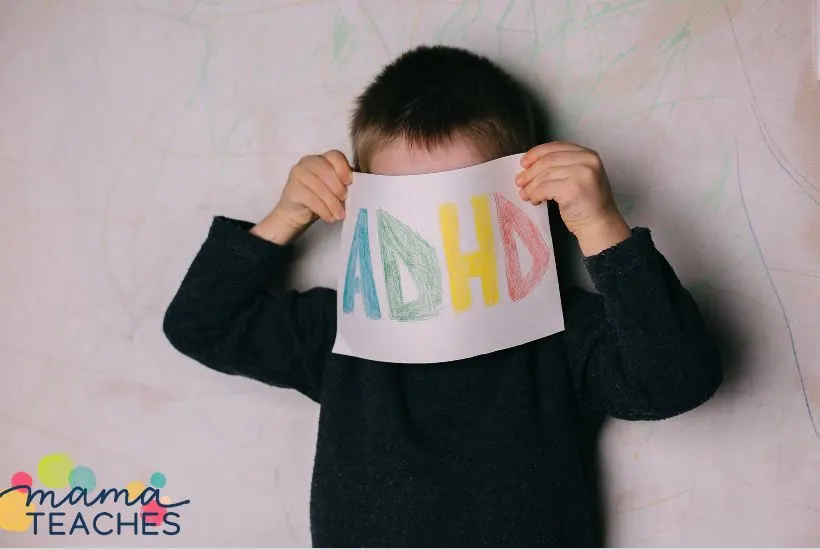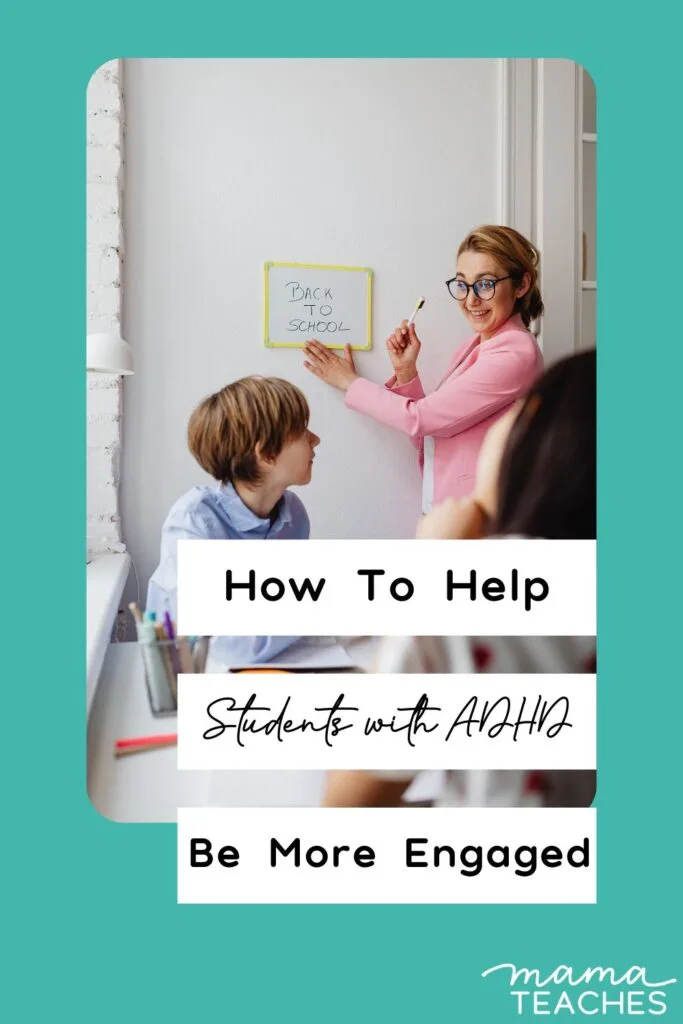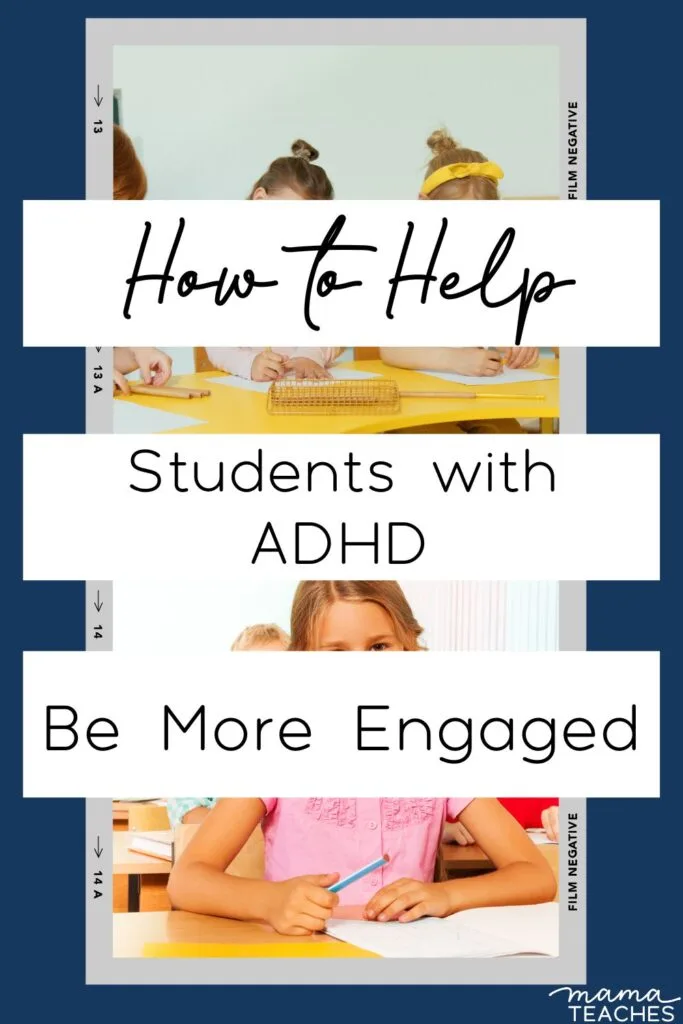How do you help students with ADHD engage in classroom learning?
Surprisingly, the answers will improve the classroom experience for all your students.

This article contains affiliate links to things that you might like.
What Is ADHD?
ADHD stands for Attention Deficit Hyperactivity Disorder.
It is quite common in children (around 10% of kids in the US have it, according to a study cited by the CDC), and it is more common in boys than girls.
It may affect your focus, ability to sit still, and impulse control.
Although ADHD can present a person with challenges, it also has benefits.
Someone with ADHD can be full of energy, which they can channel toward school, work, or athletics.
They are likely to be spontaneous and may be more willing to try new things.
People with ADHD are often creative and inventive.
Although having difficulty concentrating is an ADHD symptom, so is hyperfocus, the ability to work on a task to completion and block out all distractions.

What ADHD Looks Like in the Classroom
Only a medical professional can diagnose ADHD, but here are some ways it may manifest itself in the classroom.
And, if you’re homeschooling with ADHD, these behaviors might also manifest themselves.
Be aware that a student may only show some of these behaviors and not all of them.
Inattention
A person with ADHD may have difficulty focusing.
He or she may be easily distracted by noise (like a ticking clock or a buzzing light) or by visual stimuli like brightly colored wall art or a squirrel outside.
You may notice the student daydreaming or looking around when you are giving a lesson.
The student may have trouble following directions or finishing tasks.
Sometimes you may find careless mistakes in those tasks (like missed words in a writing exercise). Organizational skills are also a challenge.
He or she may forget about daily tasks or assignments.
Hyperactivity
A student with ADHD may have lots of energy.
Young children may have difficulty sitting still; teens are more likely to fidget or rock in their chairs.
A young child may squirm or wriggle in his seat.
He may have the urge to run or climb on things (whereas teens will have a restless feeling).
Kids with ADHD tend to talk a lot and are energetic and driven.
Impulsivity
Students with ADHD may have problems with impulse control.
They may blurt out answers or interrupt.
They may have trouble waiting their turn (and waiting in general).
If you give a “don’t” instruction, like “Don’t peek at the experiment’s results,” they may be gripped by a desire to do it and follow that impulse.

Ways to Support Students with ADHD
While it’s true that students with ADHD may be more demanding on your time and energy as a teacher, you must remember that you are one of the most influential people in that student’s life.
It is difficult for students to manage ADHD; they often have trouble fitting in at school and having a positive sense of self.
You should always work with the parents and the school psychologist to accommodate the student as much as you are able.
The good news is that many of the supports for students with ADHD will also benefit the other students in your classroom.
Establish Rules and Routines
Students with ADHD struggle with new situations.
Communicating rules and routines can help your students with ADHD stay organized and confident.
Post these rules and schedules in a visible place.
Have set patterns and spaces for turning in assignments and gathering supplies.
Post Assignments and Due Dates
Post a calendar with the dates of quizzes and tests.
Keep a running list of upcoming assignments and due dates in the corner of your board.
Remind the students to look at the board at the beginning of class until it becomes routine.
Use Reminders
Over time, students with ADHD will develop coping strategies to help themselves stay organized (just remember, Rome was not built in a day).
You can help them along in this process by using brightly colored sticky notes, to-do lists, or flashcards for them to take home.
Have set times where you open up the student planner and attach these reminders.

Be Considerate with Seating Assignments
Students with ADHD do better when they sit toward the front of the classroom.
They also tend to do better at individual desks or paired desks.
They may also thrive with flexible seating, like wiggle stools or exercise balls.
Use Graphic Organizers
Organizing their thoughts can be a challenge for students with ADHD.
By posting step-by-step directions or using graphic organizers, you can help your students finish tasks to completion.
You may also consider providing a checklist for assignments. (e.g., Is your name on the top?
The date?
Do your sentences start with capital letters? And so on.)
Hold Brain Breaks
Everyone needs to get up and move between focused tasks.
This is all the more true for students with ADHD.
Plan for brain breaks throughout the day.
It may feel like a time suck, but it will actually make your class time more productive.
You might also want to check out these natural ways to increase dopamine for ADHD because dopamine depletion can have a significant impact on a child’s ability to function in the classroom.
Even walking with kids around the school can make a huge difference in how they’re able to focus once you get back to lessons!
Help with Transitions
After an activity like lunch, recess, or PE, you can help your students with ADHD to transition to class time by giving them a calming activity that requires some movement.
You can do a kinesthetic breathing activity as a class (like STAR breathing, pretzel breathing, or balloon breathing).
You can ask them to wipe down the board or hand out papers.
These simple steps can help smooth the transition from free time to class time.
Minimize Homework
Everyone will appreciate this!
Students with ADHD are often mentally exhausted after spending a day struggling to pay attention.
Minimize homework or allow time in class to complete it.
If you must assign it, aim for multiple choice or fill-in-the-blank.

Engage the Senses
Students with ADHD thrive with kinesthetic learning.
Too often, our lessons are only visual or auditory in approach.
We require students to be passive absorbers of information.
To better engage all your students, make your lessons more hands-on.
Incorporate activities and movement into your lesson time.
Helping Students with ADHD Thrive in the Classroom
You can genuinely make a difference in the lives of your students.
This is undoubtedly true for those students with ADHD.
You are one of the main influences in their lives.
Help support them by structuring your class to engage them better.

Cindy
Monday 6th of November 2023
I think the helping with transitions tip is helpful in any environment, not just school!
marye
Tuesday 31st of October 2023
Thanks so much for this insightful information about adhd.! I found the part about transition to be particularly helpful.
Cynthia
Friday 27th of October 2023
These adhd tips are so helpful for the school year, and beyond! Thank you!
One Crazy House
Friday 27th of October 2023
I really appreciate how much information is available about adhd now!
Rita Joy
Thursday 26th of October 2023
Thank you for giving such great ideas specifically for adhd! This is so helpful.